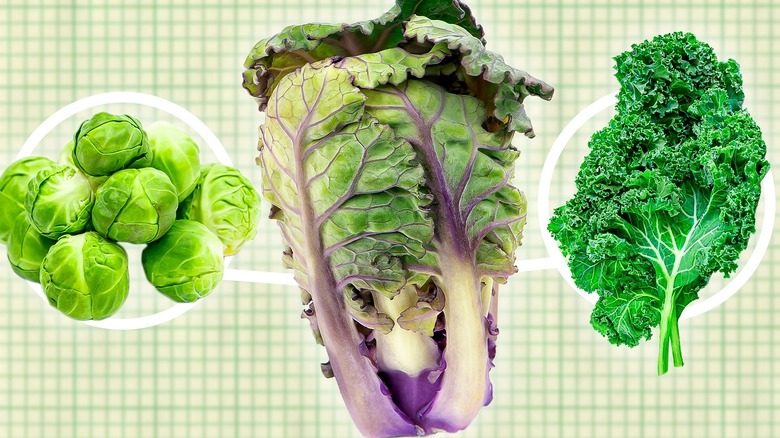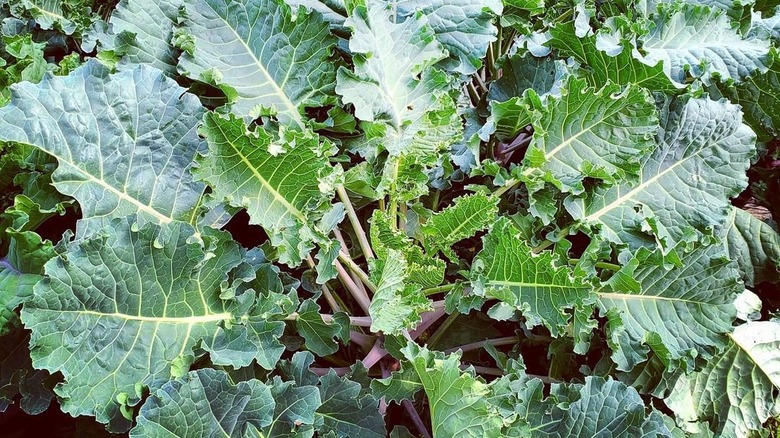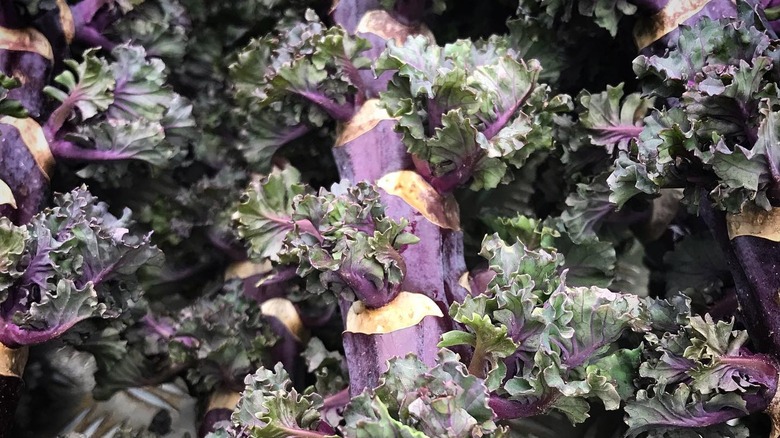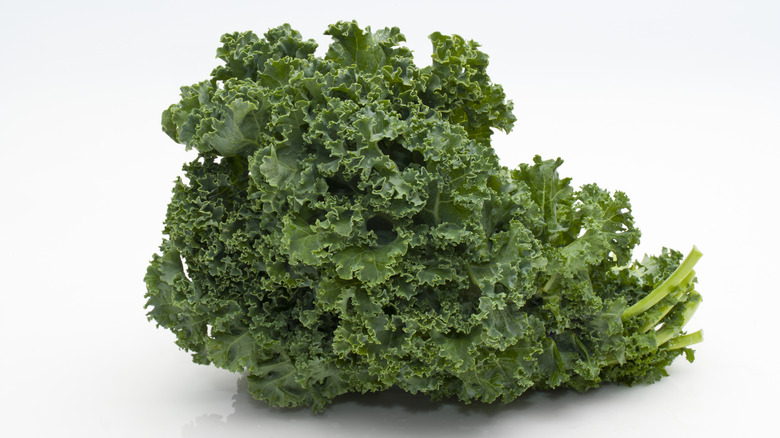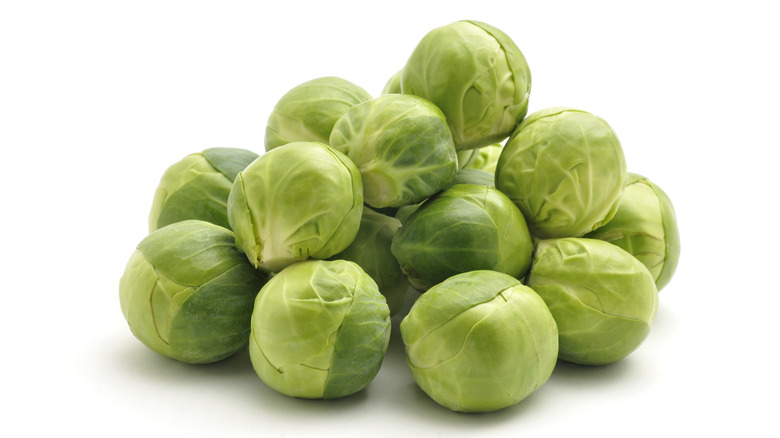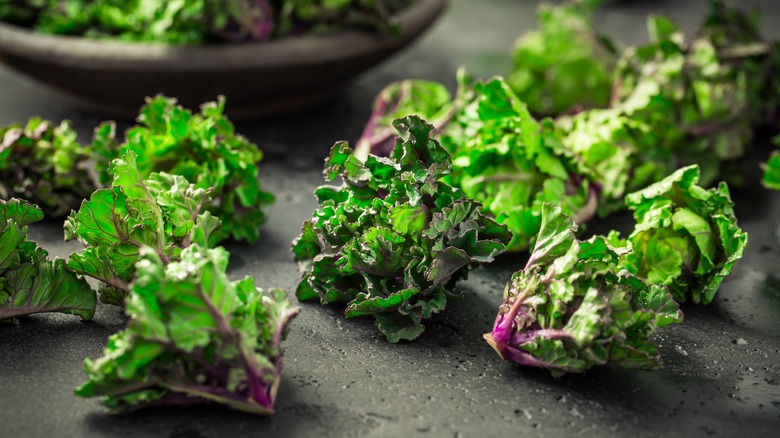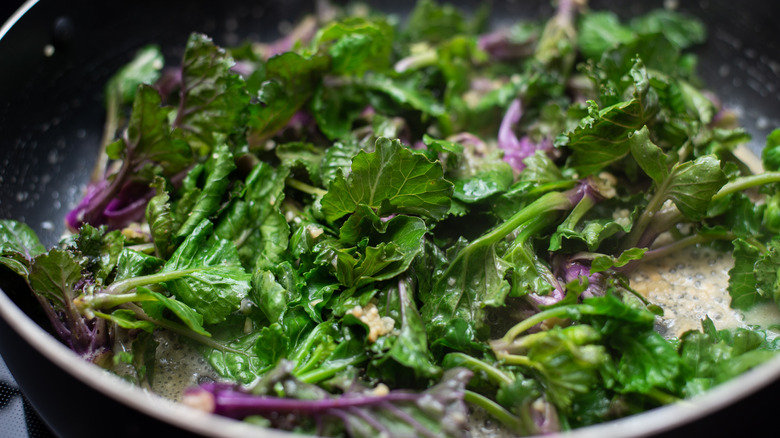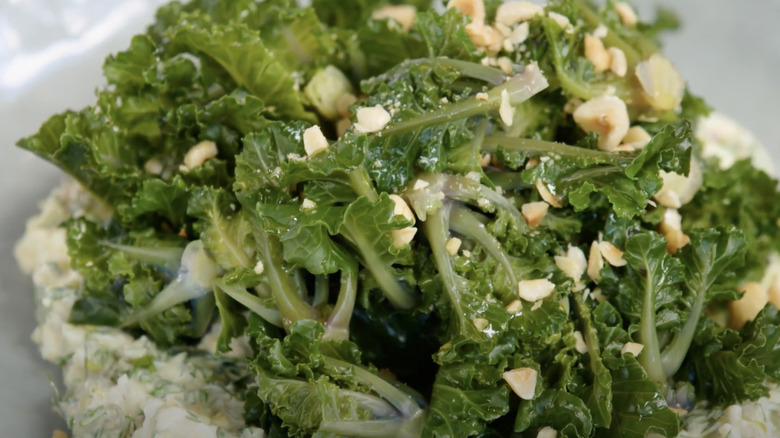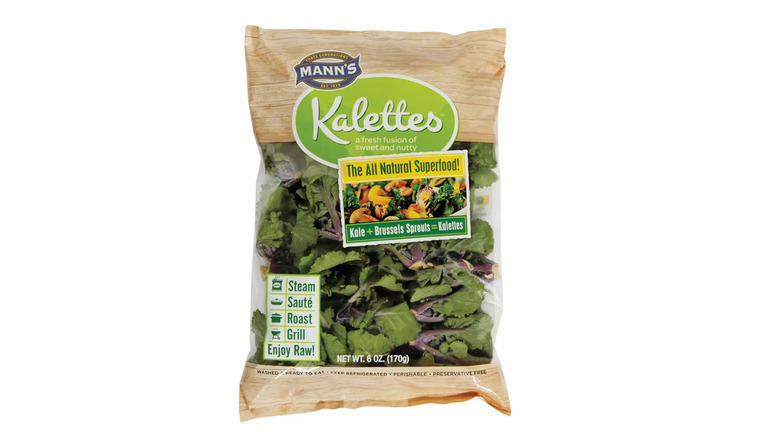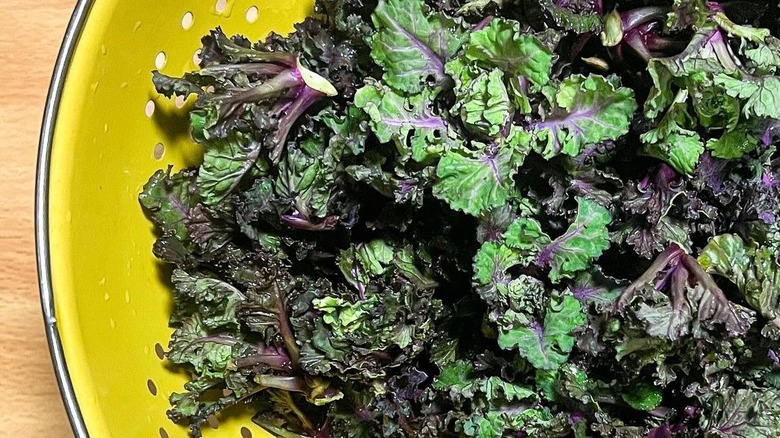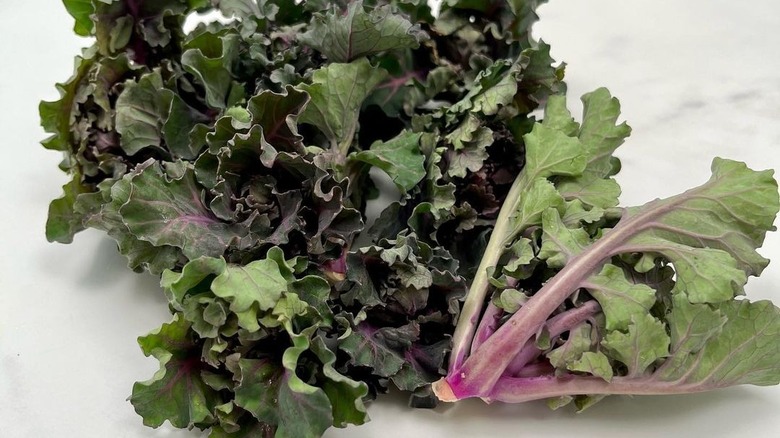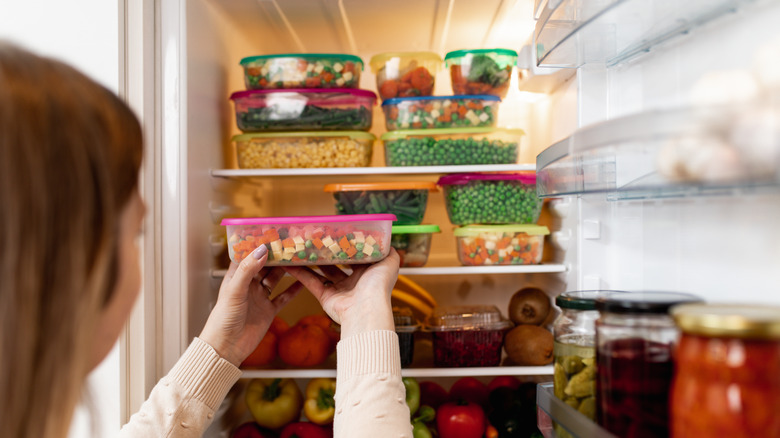Kalettes Are The Kale And Brussels Sprouts Mashup You Need To Try
The food landscape is constantly evolving, and with it, how and what we eat. At grocery stores, new varieties of fruits and veggies seemingly appear out of thin air. Everyone's familiar with Red Delicious. Although at one point the poster child for apples, today's produce section offers a much wider selection. Just as orchardists use cross-pollination to create new apple varieties, growers are combining and cultivating to create other completely new fruits and veggies.
Whether you know it or not, your favorite vegetable may be a human-made hybrid. Hybrids are fruits or vegetables created by mating two varieties or cultivars of the same species or genus, unlike GMOs, which are made in a lab. Aside from taste and nutrition, hybrid foods are more resilient in harsh conditions and offer consistent growth patterns. Broccolini and tangelos are two examples of popular hybrids commonly sold at grocery stores.
Kalettes are a newer hybrid dark leafy green variety that has recently gained popularity. A fusion of kale and Brussels sprouts was created by a British vegetable-breeding company named Tozer Seeds and introduced to the U.S. in the fall of 2014. But what are these cute-sized leafy greens? We look to answer that question and more with a detailed overview of what's sure to become a new favorite.
What are kalettes?
Kalettes, also known as flower sprouts and kale sprouts, are a hybrid of kale and Brussels sprouts. More specifically, they are small, curly-leafed purple and green sprouts that resemble kale leaves but grow on a stalk. Kale and Brussels sprouts are compatible, and both come from the Brassica oleracea species. Kalettes were originally promoted to Americans as the hot hybrid follow-up to broccolini, which was introduced in 1998.
Tozer Seeds created kalettes in response to a decline in demand for Brussels sprouts in the U.K. at the time. The company hoped that the new offering would inspire people to eat more Brussels sprouts. In its initial release, kalettes were sold by one grower and grocery store only. The subsequent success inspired Tozer Seeds to showcase it at Fruit Logistica, an agriculture trade show in Berlin. There, it came in 3rd place in the annual innovation awards, leading the company to push for the U.S. market.
How are kalettes bred?
It took nearly 15 years for Tozer Seeds to create market-ready kalette greens. Developing new species requires patience; it takes a year to see the effects of a single adjustment. The company hoped to offer a vegetable as attractive, versatile, and easy to cook as kale. Initial experimentation began in 1995 with Dr. Jamie Claxton, who was newer to the company at the time but inspired further research after successfully producing the first kalette. Kalette seeds are sown in March, harvested beginning in mid-November, and usually stay in season through the following March. The sowing to harvesting period can vary based on the climate of the region.
Kalettes are grown and harvested similarly to Brussels sprouts but need more time to mature. Depending on the variety, it can take 110 days to 138 days. Fertile soil with a pH of 6.5-7.5 is ideal, along with adequate irrigation. If it contains too much nitrogen, you'll end up with unattractive, overly leafy florets, so for best results, kalettes should be grown in cool weather and fertilized at 75% of the nitrogen used for Brussels sprouts.
Kalettes vs. kale
Despite having similarities, kalettes differ from kale in several ways, most noticeably in appearance. Miniature leafy Brussels sprouts are one way to describe them. While there are many different types of kale, kalettes tend to resemble the red kale variety. The leaves grow from axils along the stem, similar to Brussels sprouts, but have a more floral look.
They have a salad-ready texture that is more tender than kale's almost collard-like consistency. You don't need to remove the stem either; simply dig into the crunchy and earthy goodness. Whereas kale can sometimes taste bitter, kalettes are sweeter and softer on the palate. Both go great in salads; kale just requires more preparation, so it all comes down to preference.
In cooking, the two can be used interchangeably, but kale is the way to go if you prefer a grassy taste. Kale also wins in the nutritious department, containing 140% of the daily recommended amount of vitamin C.
Kalettes vs. Brussels sprouts
Kalettes' other leafy parent is notoriously known for putting frowns on the faces of children. Quasi-similar in appearance yet more leafy, Brussels sprouts are native to the Mediterranean and have been grown since the 13th century. They taste grassy like kale but carry an even more robust earthiness. If you're part of the anti-Brussels sprouts club, kalettes have an accessible taste that you might prefer. Both can be enjoyed raw, but Brussels has considerably more bite and bitterness, which makes them an acquired addition to salads.
Across Britain and America, Brussels sprouts are a popular appetizer on many restaurant menus. They're commonly sauteéd, flash-fried, roasted, or braised and paired with bacon, balsamic vinegar, and more. Kalettes can be prepared in the same ways, but due to their tender consistency, they cook faster and are easier to over-flavor. Nutrition-wise, Brussels sprouts and kalettes are both great sources of fiber, with kalettes offering a bit less.
Kalettes taste like a hybrid of both its parent plants
What you can expect from biting into a kalette is a taste similar to baby kale. Unlike mature kale, which is robust, earthy, and bitter, the immature variety has a milder taste and is tender with a chewy consistency. Thanks to its Brussels sprouts half, kalette's complex flavor profile also includes sweetness and nuttiness. It's the best of both leafy green worlds.
When seasoned and paired with other foods, it plays the role of both parent plants, but with subtlety. Whereas Brussels sprouts carry a noticeable funkiness, and kale can be overly toothsome, kalettes fit right in. Their easy preparation makes them the perfect addition to a wide range of dishes, and they are also a great addition to fresh pressed juices and smoothies. Add them to the menu of your next dinner party, and guests will definitely be in for a treat.
Cooking kalettes is easy peasy
Kalettes can be prepared in a variety of ways and fairly easily, too, even for beginners. Although roasting is the most popular, you can cook them just like Brussels sprouts and kale. Sauteéing, pan-frying, grilling, and braising are all fair game. The best part? Kalettes take less time to cook than Brussels sprouts and also don't require as much prep. When roasting, 475 degrees F is the ideal temperature for succulent caramelized kalettes with a crispy bite. It'll only cost you 10 minutes of your time to enjoy a taste that's sure to stick with you all day.
You can flavor kalettes with chopped garlic, mushrooms, and onions for an easy snack, or switch it up with your preferred combination of leafy green-friendly ingredients. Drizzle them with your favorite salad dressing or savory sauce for a delicious and nutritious meal. Avoid boiling kalettes, though, as they are too light to absorb hot water and will quickly turn soggy.
Kalettes pair perfectly with many recipes
These versatile bundles of leafy goodness are tasty enough to be enjoyed with only oil and sea salt. Those into the natural vegetable flavor will love adding kalettes to salads; they're the perfect substitute for blends that include Brussels sprouts. Savory and nutrient-rich, try swapping Brussels for kalettes in this broccoli and bacon salad recipe. Put a sweeter touch on this refreshing Brussels sprouts slaw recipe and transform it into a kalette slaw. Those are but two of countless salads perfect for an upgrade.
A little seasoning and sauce can take kalettes to another level. Things only get tastier when cooked, and this garlic and butter Brussels sprouts recipe is just dying for a kalette switcharoo. You can shave the 8-minute cooking time by half, which leaves you with more time to relax and dig in. For a filling and fanciful spin on kalettes, this parmesan pastry-wrapped Brussels sprouts recipe is sure to wow dinner guests or simply satisfy the family. As you can see, there are endless ways to enjoy kalettes.
You can only purchase them from select retailers
Although kalettes have been around since 2014, there are still lots of people who have never heard of them. You can buy these leafy florets fresh on a stalk and pre-packaged as well. Unlike Brussels sprouts and kale, most major grocery stores do not commonly stock kalettes. When they do, it's only in limited quantities, as searching online yields few results. Nationwide retailer Kroger carries kalettes, yet you'll have to call specific locations to check if they are in stock first. They appear on the company's website, but it says "Item Unavailable."
Kroger owns several major grocery brands along the West Coast as well, some of which include Food 4 Less, Fred Meyer, and Ralphs. There is a possibility that one of these stores carries kalettes. Texas-based private supermarket chain H-E-B offers a brand called Mann's, which sells pre-packaged kalettes. There are over a hundred locations throughout Texas. Costco was reported to carry pre-packaged kalettes in 2020 and even lists them in the company's inventory, yet it isn't clear whether they still do.
Another way to get your hands on kalettes is by ordering them as part of a seasonal produce box. New York City-based produce delivery service Farm To People offers them as an option to add to your assortment when in season. Sadly, at the moment, they appear to be out of stock.
Kalettes are doubly nutritious
It's no secret that eating leafy greens is great for your health, and kalettes are packed with the same superfood goodness as their plant parents. According to the U.S. Department of Agriculture, just 100 grams of kalettes contains 4.71 grams of protein, compared to 2 cups (or 240 grams) of Brussels sprouts, which have only 4 grams. Kale provides a similar amount of protein, while both plant parents offer considerably more fiber. Although less fibrous, it contains a comparable amount of vitamin K, which helps prevent blood clotting and improves bone health, and a good amount of vitamin C, which helps with iron production and immune support.
Kalettes are antioxidant-rich, too, and help defend your body from harmful free radicals. For instance, one 85-gram bag of the aforementioned Mann's Kalettes contains 150 milligrams of calcium (12% DV), 1.8 milligrams of iron (10% DV), and 470 milligrams of potassium (10% DV). Simply put, kalettes are not only super tasty, but they are a superfood that you should consider adding to your diet too.
There are several breeds of kalettes
If your local grocery store happens to have kalettes available, it may stock one of several breeds. Maine-based seed breeder Johnny's Selected Seeds grows three varieties named Autumn Star, Mistletoe, and Snow Drop respectively. The biggest distinguishing characteristic between the three is how quickly each matures when sowed. Grocery stores that operate along the west coast will most likely stock all kalette types interchangeably, while if you reside in the Deep South, Autumn Star and Mistletoe are the most common.
The North and Midwest sell all three varieties as well, with Autumn Star and Mistletoe again being most common in the Mid-Atlantic states. Regardless of the variety, kalettes generally require a little under five months to mature. Whether Autumn Star, Mistletoe, or Snow Drop, you can expect the same deliciously sweet, earthy, and nutty taste. In fact, choosing between varieties is the least of your concerns, as actually finding a local stockist may be more of a challenge.
Keep kalettes fresh and vibrant with proper storage
If you manage to procure some of these rare beauties, storing them properly is a must. The last thing you want is to open your crisper drawer to find soggy, inedible greens. Like similar vegetables, kalettes should be stored in the refrigerator unwashed until you are ready to use them. Generally, the suggested storage temperature is 36 degrees F with 100% relative humidity. Crisper drawers are fitted with vents that allow you to control the humidity — opening the vent reduces humidity, while closing does the opposite.
Keeping vegetables fresh for longer periods is easy if you store them according to their type. In general, leafy-green vegetables like kalettes should be stored in high humidity. Avoid plastic produce bags, as they prevent veggies from receiving exposure to oxygen, which aids in sugar digestion via cellular respiration. Simply put, plastic bags speed up the aging process. When you're ready to chef up a delicious kalette recipe, you can rejuvenate the leaves by trimming the ends and giving them a quick cold water bath.
